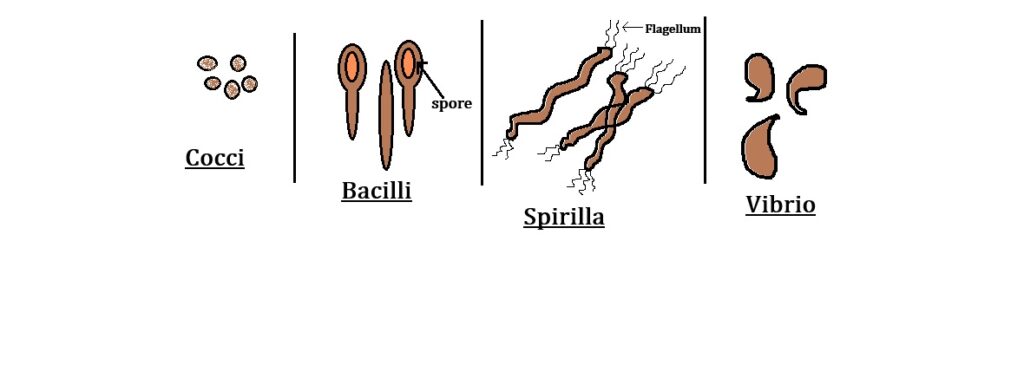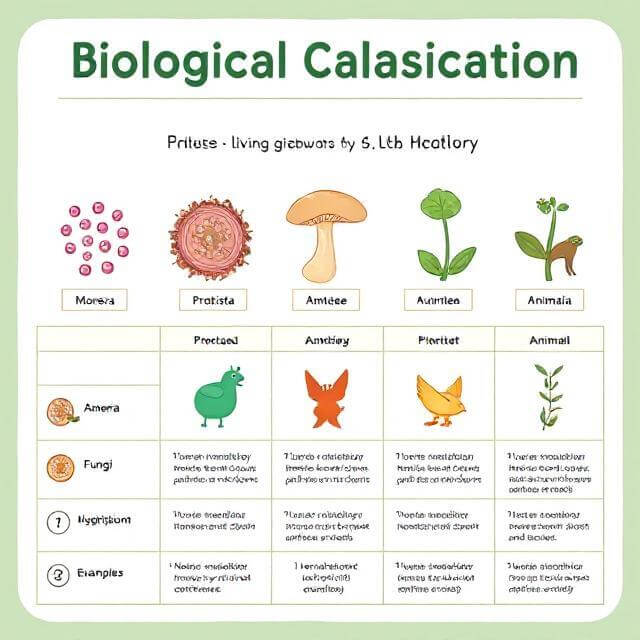Biological Classification Class 11 Free High Quality Notes for NEET
Here we cover detailed complete Neet notes of Biology, Chapter Biological Classification, Class 11 Science
1. Classification of Living Organisms – Evolution from Ancient to Modern Systems
From the very beginning of human civilization, people have been trying to classify living organisms. Initially, this was done without any scientific method. Instead, the classification was based on human needs like food, shelter, and clothing.
Aristotle’s Contribution – First Step Towards Scientific Classification
The first person to attempt a more scientific classification was Aristotle.
- He classified plants based on their structure (morphology) into three groups:
➤ Trees
➤ Shrubs
➤ Herbs - He also divided animals into two major groups:
➤ Those with red blood (like vertebrates)
➤ Those without red blood (like invertebrates)
This system was simple but laid the foundation for future classification systems.
Two Kingdom Classification by Linnaeus
In the time of Linnaeus, scientists proposed a Two Kingdom System:
Understanding Biological classification is essential for organizing the vast diversity of life.
- Kingdom Plantae – included all plants
- Kingdom Animalia – included all animals
This system looked neat and easy but had major drawbacks:
❌ Problems with the Two Kingdom Classification:
- It did not separate:
- Prokaryotes (like bacteria) from eukaryotes (like fungi)
- Unicellular organisms from multicellular
- Photosynthetic organisms (like green algae) from non-photosynthetic (like fungi)
- Many organisms did not fit clearly into either Plantae or Animalia. For example:
- Fungi – don’t perform photosynthesis
- Euglena – behaves like both plant and animal
Hence, this system was found incomplete and outdated with time.
Need for Better Classification – Evolving Scientific Approach
Scientists realized that morphology (external appearance) alone wasn’t enough.
They needed to consider many other characteristics, such as:
- Cell type (Prokaryotic or Eukaryotic)
- Nature of cell wall
- Mode of nutrition (autotrophic or heterotrophic)
- Habitat (aquatic, terrestrial, parasitic)
- Reproduction methods (asexual, sexual)
- Evolutionary relationships
Because of this, new classification systems were developed which were more accurate and detailed.
Changing Number of Kingdoms Over Time
While Plant and Animal Kingdoms always remained in some form, scientists started understanding that:
- Many organisms don’t belong to either kingdom.
- The definition of kingdoms changed as knowledge grew.
- Over time, scientists proposed three, four, five, even six kingdoms to fit the growing complexity of life forms.
✅ Conclusion
The classification of living organisms has evolved from simple, use-based grouping to complex, scientific systems. Today’s systems are built not just on what organisms look like, but on what they are made of, how they function, and how they have evolved. This evolution in classification helps us better understand the vast diversity of life on Earth.
2. Five Kingdom Classification – R.H. Whittaker’s System
In 1969, R.H. Whittaker proposed a new, more scientific system to classify all living organisms. This system is known as the Five Kingdom Classification and includes:
👉 Monera
👉 Protista
👉 Fungi
👉 Plantae
👉 Animalia
🧪 Basis of Whittaker’s Classification
Whittaker used scientific criteria to divide organisms, such as:
- Cell type (Prokaryotic or Eukaryotic)
- Cell wall composition
- Nuclear membrane (Present or Absent)
- Body organisation (Unicellular, Tissue level, Organ level)
- Mode of nutrition (Autotrophic or Heterotrophic)
- Reproduction and Evolutionary Relationships (Phylogenetics)
🧬 Overview of the Five Kingdoms
Let’s understand the key features of each kingdom:
🔹 Kingdom Monera
- Cell Type: Prokaryotic
- Cell Wall: Non-cellulosic (made of polysaccharides + amino acids)
- Nuclear Membrane: Absent
- Body Organization: Unicellular (cellular level)
- Nutrition: Both Autotrophic (chemosynthetic & photosynthetic) and Heterotrophic (saprophytic/parasitic)
- Examples: Bacteria, Cyanobacteria
🔹 Kingdom Protista
- Cell Type: Eukaryotic
- Cell Wall: Present in some
- Nuclear Membrane: Present
- Body Organization: Unicellular (cellular level)
- Nutrition: Autotrophic and Heterotrophic
- Examples: Amoeba, Paramoecium, Chlamydomonas, Chlorella
🔹 Kingdom Fungi
- Cell Type: Eukaryotic
- Cell Wall: Present (made of chitin)
- Nuclear Membrane: Present
- Body Organization: Multicellular (loose tissue level)
- Nutrition: Heterotrophic (Saprophytic or Parasitic)
- Examples: Yeast, Moulds, Mushrooms
🔹 Kingdom Plantae
- Cell Type: Eukaryotic
- Cell Wall: Present (made of cellulose)
- Nuclear Membrane: Present
- Body Organization: Tissue/organ level
- Nutrition: Autotrophic (Photosynthetic)
- Examples: Algae, Mosses, Ferns, Gymnosperms, Angiosperms
🔹 Kingdom Animalia
- Cell Type: Eukaryotic
- Cell Wall: Absent
- Nuclear Membrane: Present
- Body Organization: Tissue/organ/organ system level
- Nutrition: Heterotrophic (mainly holozoic, some saprophytic)
- Examples: Humans, Insects, Fish, Birds, Mammals
❗ Problems with Earlier Classification Systems
Before Whittaker’s system:
- All organisms with cell walls were grouped under Plants, including:
- Bacteria
- Cyanobacteria (blue-green algae)
- Fungi
- Mosses, Ferns, and Flowering Plants
But this caused problems:
- Bacteria and blue-green algae are prokaryotic, others are eukaryotic
- Fungi are heterotrophic with chitin wall, unlike green plants which are autotrophic with cellulose wall
- Chlamydomonas (unicellular) and Spirogyra (multicellular) were both placed in Algae, ignoring major differences
🌐 Why New Classification Was Needed
Whittaker’s system corrected these errors by:
- Separating prokaryotes into Monera
- Grouping unicellular eukaryotes under Protista
- Creating a separate kingdom for Fungi due to their distinct nutrition and cell wall
📚 Modern Developments – Three Domain System
Later on, a Three-Domain System was proposed:
- Monera was divided into two domains:
- Bacteria
- Archaea
- The remaining kingdoms (Protista, Fungi, Plantae, Animalia) were placed in the third domain: Eukarya
You will study this system in detail in higher classes.
✅ Conclusion
The Five Kingdom Classification by R.H. Whittaker provided a more accurate and evolutionary-based way to group organisms. It was a big improvement over older systems because it:
- Considered cell type, body organization, nutrition, and evolutionary relationships
- Solved the confusion in placing organisms like fungi, bacteria, algae, and protozoa
- Laid the foundation for modern taxonomy and phylogeny
As our knowledge increases, classification systems will continue to evolve in the future.
2. Kingdom Monera – Characteristics of Bacteria
Kingdom Monera includes only one major group of organisms – the bacteria. These are the simplest and most ancient life forms on Earth, but they are also among the most adaptable and diverse.
🌍 Habitat – Where Are Bacteria Found ?
Bacteria are found everywhere – they are the most abundant microorganisms on Earth.
- A handful of soil can contain hundreds of bacteria.
- They live in extreme environments:
- Hot springs
- Deserts
- Snow-covered regions
- Deep oceans
- Some bacteria live on or inside other living organisms as parasites.
🔬 Types of Bacteria Based on Shape
Bacteria are grouped into four main types based on their shape:
| Shape | Name | Plural Form |
|---|---|---|
| Spherical | Coccus | Cocci |
| Rod-shaped | Bacillus | Bacilli |
| Comma-shaped | Vibrio | Vibrio |
| Spiral-shaped | Spirillum | Spirilla |
This classification helps scientists identify and study bacteria more efficiently.

🧪 Structure vs Behaviour
Even though bacteria have a very simple cell structure (no true nucleus or membrane-bound organelles), their behavior is complex and advanced.
They display huge diversity in metabolism, making them one of the most biochemically versatile organisms.
🍽️ Nutrition in Bacteria
Bacteria can be classified based on how they obtain food:
🔹 Autotrophic Bacteria – Make their own food
- Use inorganic substances to prepare food
- Two types:
- Photosynthetic autotrophs – use sunlight (e.g., cyanobacteria)
- Chemosynthetic autotrophs – use chemical reactions (e.g., nitrifying bacteria)
🔹 Heterotrophic Bacteria – Depend on others for food
- Most bacteria fall under this category
- They get nutrition from:
- Dead organic matter (saprophytic)
- Living hosts (parasitic)
✅ Conclusion
Kingdom Monera, consisting of bacteria, includes some of the most widespread and adaptable organisms on Earth.
They:
- Live in extreme environments
- Exist in various shapes
- Have simple structure but complex metabolic activity
- Show diverse modes of nutrition, both autotrophic and heterotrophic
Their incredible metabolic diversity makes bacteria vital for ecosystems and human life.
Kingdom Monera has of two Types- Archaebacteria and Eubacteria.
Archaebacteria – Ancient Survivors of Extreme Environments
Archaebacteria are a unique and ancient group of bacteria that belong to Kingdom Monera. They are known for living in some of the most extreme and harsh environments on Earth—places where most other life forms cannot survive. Based on the habitats they thrive in, archaebacteria are classified into three major types:
- Halophiles – found in extremely salty environments, like salt lakes
- Thermoacidophiles – survive in hot springs with very high temperatures and acidic conditions
- Methanogens – live in oxygen-free, swampy or marshy areas, such as the digestive tracts of ruminants (e.g., cows and buffaloes)
The reason archaebacteria can survive such extreme conditions lies in their special cell wall structure, which is very different from that of other bacteria. This unique composition protects them from high salt levels, acidity, and heat, making them extremely resistant and adaptable.
One of the most important types of archaebacteria are methanogens, which play a crucial role in the production of biogas. These bacteria live inside the intestines of ruminant animals like cows and buffaloes, where they help in the breakdown of organic matter in the gut and release methane gas as a byproduct. This methane is then collected and used as biogas, a renewable source of energy, especially in rural areas.
✅ Conclusion
Archaebacteria are primitive, microscopic organisms that have adapted to survive in extreme environments through their specialized cell wall structure.
- They include halophiles, thermoacidophiles, and methanogens
- Methanogens are especially useful in the production of methane (biogas) from animal dung
- Despite their simple structure, they play a vital ecological and environmental role
These ancient microbes show how life can adapt and thrive even under the harshest conditions on Earth.
Eubacteria – The True Bacteria with Diverse Roles and Forms
Eubacteria, also known as true bacteria, are one of the most widespread and diverse groups of microorganisms found in nature. They belong to Kingdom Monera and exist in thousands of different forms. These bacteria are recognized by their rigid cell wall, and many of them also have a flagellum that helps them move (motile bacteria).
🌱 Photosynthetic Autotrophs – Cyanobacteria (Blue-Green Algae)
One important group of eubacteria is the cyanobacteria, commonly referred to as blue-green algae. These are photosynthetic autotrophs, meaning they produce their own food using sunlight just like green plants. They contain chlorophyll-a, which is the same pigment used by higher plants for photosynthesis.
Cyanobacteria may be:
- Unicellular, colonial, or filamentous
- Found in freshwater, marine, or terrestrial environments
- Surrounded by a gelatinous sheath in colonies
They often form blooms in polluted water bodies, creating thick layers on the water surface. Some cyanobacteria like Nostoc and Anabaena have specialized cells called heterocysts that can fix atmospheric nitrogen – a very important ecological function.

⚗️ Chemosynthetic Autotrophic Bacteria
These bacteria do not use sunlight but derive energy by oxidizing inorganic substances such as:
- Ammonia
- Nitrites
- Nitrates
The energy released is used to produce ATP, the energy currency of the cell. These bacteria play a major role in nutrient recycling, especially for elements like:
- Nitrogen
- Phosphorus
- Iron
- Sulphur
🍽️ Heterotrophic Bacteria – Decomposers and Pathogens
The majority of eubacteria are heterotrophs, which means they depend on other organisms or organic matter for food. These are:
- The most abundant bacteria in nature
- Act as important decomposers by breaking down dead plants and animals
- Play key roles in human life, such as:
- Making curd from milk
- Producing antibiotics
- Fixing nitrogen in legume roots (e.g., Rhizobium)
However, not all are friendly. Some heterotrophic bacteria are pathogens, which cause diseases in humans, plants, and animals. Common bacterial diseases include:
- Cholera
- Typhoid
- Tetanus
- Citrus canker (affects crops)
🔁 Reproduction in Eubacteria
Eubacteria mainly reproduce by:
- Binary fission – a simple, asexual method of cell division
- In unfavourable conditions, they form spores for survival
- They can also perform a primitive form of sexual reproduction through DNA transfer from one bacterium to another (no gamete formation)
🦠 Mycoplasma – Exception Among Bacteria
A special group related to eubacteria is Mycoplasma:
- They lack a cell wall completely
- Are the smallest living cells known
- Can survive without oxygen
- Many mycoplasmas are pathogenic to both animals and plants
✅ Conclusion
Eubacteria, or true bacteria, are incredibly versatile and essential organisms that impact ecosystems and human life in numerous ways.
- They include photosynthetic cyanobacteria, nutrient-recycling chemosynthetic bacteria, and useful heterotrophs involved in food production and medicine
- At the same time, they also include harmful pathogens
- Their simple structure supports a variety of reproduction methods, helping them adapt and survive
Alongside them, mycoplasma remind us of the diversity of life, surviving even without cell walls or oxygen.
3. Kingdom Protista
Kingdom Protista includes all single-celled eukaryotic organisms. That means, these organisms have only one cell, but that cell is advanced – it has a proper nucleus and membrane-bound organelles (like mitochondria, etc.).
Protists mostly live in water (aquatic environment). Some look like plants, some like animals, and some like fungi – that’s why this kingdom is considered a link between plants, animals, and fungi. Scientists sometimes find it hard to decide if an organism should be called a protist, a plant, or something else.
Some protists can move with the help of cilia (small hair-like structures) or flagella (tail-like structures).
These organisms can reproduce in two ways:
- Asexually – by simple cell division.
- Sexually – by fusion of two cells to form a zygote.
Important groups included in Protista are:
- Chrysophytes
- Dinoflagellates
- Euglenoids
- Slime Moulds
- Protozoans
Each of these groups has different features. Some are plant-like (photosynthetic), some are animal-like (can move and eat), and some behave like fungi.
Introduction to Chrysophytes
Chrysophytes are a group of microscopic aquatic organisms that include diatoms and golden algae (also called desmids). They live in both freshwater and marine water environments. Most of them float freely in water and are part of plankton. Being photosynthetic, they can make their own food using sunlight, which makes them important for the aquatic food chain.
Diatoms have a unique cell wall made of silica, which is a glass-like substance. Their walls are formed of two overlapping parts (like a soap box with a lid). This silica wall is very hard and indestructible, so when diatoms die, their walls don’t decay. Over billions of years, the remains of their cell walls have collected at the bottom of oceans and water bodies, forming a special type of soft rock called diatomaceous earth.
This diatomaceous earth is very useful in daily life. Because it is rough and gritty, it is used for:
- Polishing surfaces
- Filtering oils and syrups
- Making industrial filters
Also, diatoms are considered the main producers in oceans, meaning they create a large amount of oxygen and organic material for other sea organisms. They play a very important role in maintaining life in aquatic ecosystems.
Dinoflagellates
Dinoflagellates are mostly marine organisms and perform photosynthesis. Depending on the pigments in their cells, they may appear yellow, green, brown, blue, or red. Their outer cell wall is made of stiff cellulose plates. They have two flagella (tail-like structures for movement) — one lies along the length of the cell (longitudinal), and the other goes around it in a groove (transverse).
Some red-colored dinoflagellates, like Gonyaulax, multiply so fast that they make the sea look red — this is called a red tide. The toxins released during red tides can be harmful and may kill fishes or other marine animals nearby.
Euglenoids
Euglenoids are mostly found in fresh and stagnant water. Unlike other protists, they do not have a cell wall. Instead, their body is covered by a protein-rich flexible layer called the pellicle, which allows them to change shape. They have two flagella for movement — one is short and the other is long.
Euglenoids are dual-natured. In sunlight, they act like plants and perform photosynthesis. But when light is not available, they act like animals and feed on smaller organisms (heterotrophic mode). Their pigments are the same as those found in higher plants.
Example: Euglena
Slime Moulds
They are saprophytic protists, meaning they feed on dead and decaying organic matter. Their body slowly moves over rotten leaves and twigs, absorbing nutrients. When conditions are favorable, they form a large, multinucleate, creeping mass called plasmodium, which can spread over a large area.
In harsh or unfavorable conditions, this plasmodium changes into fruiting bodies that produce spores. These spores have a true protective wall, making them very strong and resistant. They can survive for many years even in tough environments. The spores are carried and spread by air currents.
Protozoans
Protozoans are heterotrophic unicellular protists that live either as free-living predators or as parasites. They are considered the most primitive relatives of animals. Based on their movement and mode of life, protozoans are divided into four main groups.
Amoeboid protozoans live in fresh water, sea water, or moist soil. They move and feed using pseudopodia (false feet), just like Amoeba. Some marine types have silica shells on their surface, while parasitic forms like Entamoeba can live inside other organisms.
Flagellated protozoans may be free-living or parasitic and have one or more flagella for movement. Some parasitic forms cause diseases such as sleeping sickness, for example, Trypanosoma.
Ciliated protozoans are aquatic and covered with numerous tiny cilia. These cilia help them move and also direct food into a special cavity called the gullet. Paramoecium is a common example of this group.
Sporozoans are a group of protozoans that do not have special structures for movement. They have an infectious spore-like stage in their life cycle. The most well-known example is Plasmodium, which causes malaria, a serious disease affecting millions of people globally.
4. Kingdom Fungi
Fungi form a separate group of living organisms that are heterotrophic, which means they cannot make their own food and depend on others. They show a lot of variation in their shape (morphology) and where they live (habitat). You might have noticed fungi growing on moist bread or spoiled fruits. The mushrooms that we eat and toadstools are also types of fungi. Sometimes, white patches on mustard leaves are caused by a fungus that lives as a parasite on plants.
Some fungi are useful to us. For example, yeast is a unicellular fungus used to make bread and beer. On the other hand, some fungi cause diseases. An important example is Puccinia, which causes rust disease in wheat. Some fungi also help in making antibiotics. Penicillium is a fungus that gives us the antibiotic penicillin. Fungi are found almost everywhere – in the air, water, soil, and on living plants and animals. They mostly grow well in warm and moist (humid) places. This is the reason why we keep food in the refrigerator – to prevent fungal or bacterial spoilage.
Most fungi, except yeast, have a body made of fine, thread-like structures called hyphae. A large group of these threads together is called a mycelium. In some fungi, the hyphae do not have any divisions and contain many nuclei in a single large cell. These are called coenocytic hyphae. In other fungi, the hyphae are divided into cells by cross-walls called septa. The outer wall of fungal cells is made of chitin and complex sugars called polysaccharides.
Fungi are heterotrophic in nature, which means they get their food from other sources. Some fungi feed on dead and decaying matter – these are called saprophytes. Some fungi live on living organisms and harm them – these are called parasites. There are also fungi that live in close partnerships with other organisms, where both partners benefit. These are called symbionts. For example, fungi live with algae to form lichens and with roots of higher plants to form mycorrhiza.
Fungi can reproduce in three different ways: vegetative, asexual, and sexual reproduction. In vegetative reproduction, fungi reproduce by breaking into fragments, by fission (splitting), or by budding (a new cell forms from the old one). In asexual reproduction, they produce spores like conidia, sporangiospores, or zoospores. These spores are formed inside special structures called fruiting bodies.
Sexual reproduction in fungi occurs in three main steps. First is plasmogamy, where the cytoplasm of two parent cells (gametes) fuses. Next is karyogamy, where the nuclei fuse to form a single nucleus. Then, meiosis takes place, resulting in the formation of haploid spores. In many fungi like ascomycetes and basidiomycetes, there is a special stage between plasmogamy and karyogamy called the dikaryophase. In this stage, each cell has two separate nuclei (n + n). Later, the nuclei fuse to form a diploid cell (2n), and then meiosis occurs to form haploid spores again.
Fungi are classified into different groups based on how their mycelium looks, how their spores are formed, and what kind of fruiting bodies they produce. These features help scientists divide fungi into various classes under the kingdom Fungi.
Phycomycetes – Class of Fungi
Members of the group Phycomycetes are mostly found in wet or moist environments. They usually grow in aquatic places, on rotting wood, or in damp soil. Some members also live as obligate parasites on plants, which means they must live on a living host to survive and reproduce.
The body of these fungi is made up of mycelium, which is aseptate (meaning it has no cross walls) and coenocytic (meaning it has many nuclei in a single large cell). This kind of structure allows the fungus to grow quickly and spread easily.
Reproduction in phycomycetes takes place in both asexual and sexual ways. In asexual reproduction, they produce zoospores (which can move with the help of flagella) or aplanospores (which are non-motile). These spores are made inside a structure called the sporangium, and they develop internally (endogenously).
During sexual reproduction, these fungi form a thick-walled zygospore by the fusion of two gametes. These gametes can either look the same (isogamous) or be different in shape or size (anisogamous or oogamous). This type of fusion ensures genetic variation in the next generation.
Some commonly known examples of phycomycetes are:
- Mucor – found on decaying organic matter
- Rhizopus – commonly known as bread mould
- Albugo – a parasitic fungus that infects mustard plants
Ascomycetes – Class of Fungi
Ascomycetes are a group of fungi commonly called sac fungi because their sexual spores are formed inside a sac-like structure. Most ascomycetes are multicellular, such as Penicillium, but a few like yeast (Saccharomyces) are unicellular.
These fungi can live in different ways. Some are saprophytic (feed on dead matter), some act as decomposers, others are parasitic (live on living organisms and harm them), and a few are coprophilous, meaning they grow on animal dung.
The body of ascomycetes is made up of branched and septate mycelium, meaning their hyphae are divided into cells by cross-walls. In asexual reproduction, they produce spores called conidia. These conidia are formed outside (exogenously) on special structures known as conidiophores. When conidia germinate, they give rise to new mycelium.
During sexual reproduction, they form spores called ascospores. These are produced inside (endogenously) in a sac-like structure called an ascus (plural: asci). These asci are grouped into special structures called ascocarps, which act as the fruiting bodies of ascomycetes.
Some commonly known examples of ascomycetes are:
- Aspergillus – a mold that can grow on food and causes spoilage
- Claviceps – known for causing a plant disease called ergot
- Neurospora – used widely in genetic and biochemical research
Many ascomycetes like morels and truffles are edible and are considered luxury food items or delicacies in many parts of the world.
Basidiomycetes – Class of Fungi
Basidiomycetes are a group of fungi that include many commonly known forms like mushrooms, bracket fungi, and puffballs. These fungi are usually found growing in soil, on rotting wood logs, tree stumps, or even inside living plants as parasites. The parasitic members include rusts and smuts, which cause diseases in crops.
The body of basidiomycetes consists of branched and septate mycelium, meaning their hyphae are divided into compartments by cross-walls. In most cases, asexual spores are not formed, but they can reproduce vegetatively by fragmentation — where a piece of the fungus breaks off and grows into a new organism.
Basidiomycetes do not have distinct sex organs. Instead, sexual reproduction begins with plasmogamy, which is the fusion of cytoplasm from two different vegetative or somatic cells (from different strains or types). This fusion leads to the formation of a dikaryotic structure, where each cell has two nuclei (n + n).
This dikaryotic stage eventually forms a basidium (plural: basidia), where the final steps of sexual reproduction occur. In the basidium, two nuclei fuse (karyogamy), followed by meiosis, resulting in the formation of four haploid spores called basidiospores. These basidiospores are formed outside (exogenously) on the basidium.
The basidia are grouped together in special structures called basidiocarps, which are the fruiting bodies of basidiomycetes.
Some common examples of basidiomycetes include:
- Agaricus – the common edible mushroom
- Ustilago – causes smut disease in crops
- Puccinia – responsible for rust disease in wheat
Deuteromycetes – Class of Fungi
Deuteromycetes are commonly known as imperfect fungi because in this group, only the asexual or vegetative phases of the fungi are known. Their sexual reproduction stages are either not observed or not identified clearly. That’s why they are called “imperfect.”
In many cases, when the sexual stage of a fungus is discovered later, the fungus is moved to its correct group, usually either Ascomycetes or Basidiomycetes, depending on its characteristics. Sometimes, the same fungus may have two different names – one for its asexual stage (classified under Deuteromycetes) and another for its sexual stage (classified elsewhere). When scientists figure out the connection between both stages, the fungus is reclassified correctly and is no longer considered part of Deuteromycetes.
Deuteromycetes reproduce only by forming asexual spores called conidia. These spores help in spreading and growing new fungal colonies. The body of these fungi consists of branched and septate mycelium, which means the hyphae are divided into cells by cross-walls.
Members of this group show different modes of living. Some are saprophytes, which means they live on dead and decaying matter. Others are parasites, living on and harming living organisms. A large number of Deuteromycetes are important decomposers of plant litter, and they help in recycling minerals in nature, making them ecologically very important.
5. Plants Kingdom
Kingdom Plantae includes all organisms that are eukaryotic (have well-defined cells with a nucleus) and contain chlorophyll, the green pigment used for photosynthesis. These organisms are commonly known as plants. Most plants make their own food using sunlight, but a few special types are partially heterotrophic — meaning they depend on other organisms for food.
Examples of such heterotrophic plants include insectivorous plants like Bladderwort and Venus flytrap, which trap and digest insects, and parasitic plants like Cuscuta (Amarbel), which grow on other plants and absorb nutrients from them.
Plant cells have a typical eukaryotic structure, meaning they have a proper nucleus and organelles. Their cells also have chloroplasts (where photosynthesis occurs) and a cell wall mainly made of cellulose, which gives them structure and strength.
The plant kingdom includes a wide range of groups such as:
- Algae
- Bryophytes (mosses and liverworts)
- Pteridophytes (ferns and their relatives)
- Gymnosperms (non-flowering seed plants like pine)
- Angiosperms (flowering plants)
Plants show a unique pattern in their life cycle known as alternation of generations. This means that they have two main phases:
- Diploid Sporophyte Phase (2n) – produces spores
- Haploid Gametophyte Phase (n) – produces gametes (sex cells)
These two phases alternate with each other in every plant’s life cycle. The length and dominance of these phases vary across different plant groups. In some, the sporophyte is more dominant and long-living, while in others, the gametophyte plays the major role.
This process of having both diploid and haploid stages, one after the other, is called alternation of generations and is a key feature of all members of Kingdom Plantae. You Study In Further Chapters🥰.
6. Animalia Kingdom
Kingdom Animalia includes all heterotrophic, eukaryotic, and multicellular organisms. Their cells do not have cell walls, which makes them different from plants. These organisms depend directly or indirectly on plants for their food. They digest food inside a body cavity and store extra food in the form of glycogen or fat.
Their mode of nutrition is called holozoic, which means they take in solid food through ingestion and then digest it. They grow by following a definite growth pattern, and become adults with a specific shape and size. Higher animals have advanced sense organs and nervous systems, which help them respond to their surroundings. Most animals can move from one place to another (locomotion).
Reproduction in animals is usually sexual, where the male and female organisms copulate and form a zygote, which then develops through embryological stages into a new individual.
7.Viruses, Viroids, Prions, and Lichens – Simple Notes for NEET
In Whittaker’s five-kingdom classification, some organisms like viruses, viroids, prions, and lichens are not included. These organisms are unique in nature and are discussed briefly below.

Viruses
Viruses are not classified as truly living organisms because they do not have a cellular structure. Outside a host cell, viruses exist as non-living, crystalline particles. However, once they enter a living cell, they become active, take control of the cell’s machinery, and replicate, often killing the host cell. This raises the question: are viruses living or non-living?
The word virus means poison. In 1892, Dmitri Ivanowsky found that a certain disease in tobacco plants (mosaic disease) was caused by something smaller than bacteria. Later in 1898, M.W. Beijerinck confirmed this and called the infectious fluid Contagium vivum fluidum (infectious living fluid). In 1935, W.M. Stanley showed that viruses can be crystallized, confirming they are non-living outside the host.
Viruses are made of a protein coat (called a capsid) and genetic material, which can be either DNA or RNA, but never both. The capsid is made of smaller units called capsomeres, arranged in helical or geometric shapes.
- Plant viruses usually have single-stranded RNA.
- Animal viruses may have single- or double-stranded RNA or DNA.
- Bacteriophages (viruses that infect bacteria) typically have double-stranded DNA.
Viruses are obligate parasites, meaning they cannot survive or reproduce without a host. They cause many diseases like flu, mumps, smallpox, herpes, AIDS in humans, and mosaic patterns, leaf curl, and stunted growth in plants.
Viroids
Viroids are even smaller than viruses and were discovered by T.O. Diener in 1971. They are small, circular RNA molecules that lack a protein coat. Viroids were first found in potato spindle tuber disease. Their RNA is of low molecular weight, and unlike viruses, viroids consist of only RNA.
Prions
Prions are infectious agents made up only of abnormally folded proteins. They do not contain any nucleic acids (DNA or RNA). Prions are known to cause degenerative neurological disorders. The most well-known prion diseases are:
- Mad cow disease (Bovine Spongiform Encephalopathy or BSE) in cattle
- Creutzfeldt–Jakob disease (CJD) in humans
Lichens
Lichens are not a single organism, but a symbiotic association between an alga and a fungus.
- The algal part is called the phycobiont, which is autotrophic (makes food using photosynthesis).
- The fungal part is called the mycobiont, which is heterotrophic (depends on the alga for food).
The alga provides food, while the fungus offers protection, water, and minerals. This relationship is so close that lichens appear as one single organism. Lichens are very sensitive to pollution and are excellent indicators of air quality, as they do not grow in polluted areas.
Thank You 💕By





